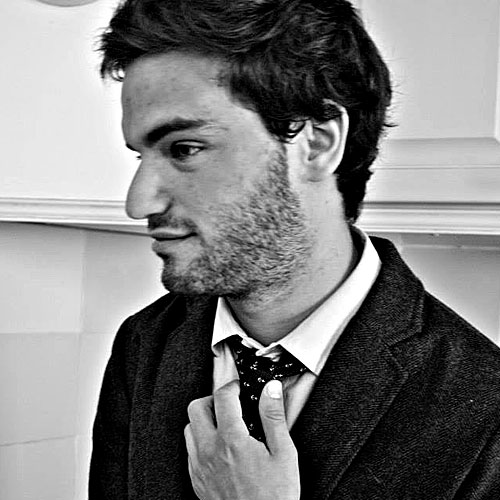A spoon hypnotically circling a saucer. A snap(shot) back to reality. The atmospheric, crushing silence of the sunken place.
If you’re hearing those sounds in your head, that’s for good reason: the aural motifs in Jordan Peele’s instantly iconic horror movie, Get Out, seem, upon retrospect, manufactured with posterity in mind.
In large part responsible for such indelible moments is the film’s sound editor, Trevor Gates—who just so happened to design the sound for another work of horror taking place in a country estate starring Lakeith Stanfield: “Teddy Perkins,” the strangest, most ambitious episode on an already-strange, highly ambitious season of Atlanta.
During the episode, directed by Hiro Murai, Darius (Stanfield) goes to the gothic mansion of Teddy Perkins (the show’s creator/star Donald Glover, in whiteface) to pick up a used piano. With his high-pitched voice, old-school smoking jacket and stilted mannerisms, Perkins is evasive, haunted and clearly hiding something—quite literally, his musically gifted and ailing brother, Benny, as well as their troubled childhood, reminiscent of the relationship between Joe and Michael Jackson. The episode climaxes in a crash of fraternal violence, resounding with powerful suddenness in the eerie quietude of the house.
“Teddy Perkins” received several well-deserved Emmy nominations, for directing, single-camera picture editing, production design, cinematography and sound editing. So ahead of the Emmy Awards next month, we caught up with Gates to talk about working on Atlanta, how he created the fragile stillness in “Teddy Perkins,” the sunken place and the scariest scene he’s seen this year.
First thing’s first: can you explain what exactly you do as a sound editor (versus a sound mixer)?
It’s my job to prepare all the sound we hear in film and TV—everything you’re hearing that’s not music, all the dialogue, all the sound that was recorded on the day of filming (production sound), all the ambiences that you hear in any given scene, sound effects like car engines and gun shots, doors opening and closing, phones ringing, and then sound that we call foley, which is a sound effect that is performed in real-time, like footsteps. Once all the sound is built and assembled, we go into a room with a rerecording mixer who takes all the sound that I prepared, blends them together and turns it into a final product.
When you get an episode like 'Teddy Perkins,' what sort of sounds are you looking to enhance or elucidate?
I’m not really in the business of throwing anything way then I think it’s fantastic. I think it’s my job to make everything homogenous and fix the things that aren’t working. There are some things that come from my colleagues from the picture department, which I only have to finesse. And there were a couple of other instances where they really didn’t have the capability to make the scene play the way [the director] envisioned it playing.
'Teddy Perkins' was one of those episodes where, conceptually, there wasn’t a ton that the picture department couldn’t do to paint the picture for us other than just tell us what the feeling was. Really, in the end, what made 'Teddy Perkins' great and what we really spent most of our time on was making it quiet.
How do you go about creating that silence?
The perceived quietness of film and TV is not an absence of sound, it’s an isolation of sound. You pick a sound or two to really focus on, and it’s quite subliminal to the audience, but it’s imperative for them to be involved. They need to suspend their disbelief, they need to feel like they’re in the space. The tone and the coldness of the room, the air that helps space the dialogue in 'Teddy Perkins,' was something we had to craft. It seems like it could be a pretty simple thing, but it requires some crafting as well as a really articulate sound mix to be able to balance the dialogue with the coldness of the house and use artificial reverbs in the room to make people feel like they’re in that cold house with Teddy and Darius.
Part of creating that cold air inside the house meant we had to be extra careful with the production sound. Whatever was recorded on the day, we had to take out every single anomaly, any creak or bump or snap, we had to go in with a fine-toothed comb make that production dialogue track razor-sharp, so we could hold that perceived silence.
How much more critical is sound editing to creating fear in a horror movie than, say, eliciting laughter in a comedy? Or is it not?
I think some people would argue that they’re all just as important, and some people would argue it’s more critical in horror and thriller. There are different ways to provide an experience and a story through different genres. And even within those genres there are different ways. In horror, you can be understated and you can be overstated, and one way can be the right way and the other way can be the wrong way, and it really has to do with the filmmaker’s taste. I have found that when I’m working with horror that’s more attuned to classic horror, quietness is something that’s more important, whereas slasher films you just want to really loud and over-the-top, with a lot of big quick sounds.
In action films and some horror there’s probably more sound, and in drama and comedy and classic horror there’s less sound, but more isn’t always more. Sometimes doing less is harder than putting more in because you don’t have anything to hide behind. And I think that’s a testament to 'Teddy Perkins,' and some places of Get Out, too. You have to make a really good decision about that one sound that you want someone to hear.
Is there a particular challenge to designing sound for something like 'Teddy Perkins,' and Atlanta in general, given it defies neat categorization?
You have to follow your instinct. And I’ll tell you I probably used every tool [in my toolkit] in one season of Atlanta, because it’s so different across all the episodes.
The saucer, the sunken place and the snap of the photo are key, from an audio perspective, in Get Out. What's the process of developing sounds like that, which are so fundamental not only to the atmosphere but the plot?
Every little motif has a different process and sometimes they get modified as we go. So the snap of the photo, this is where we have a big impact, where we get really quiet and the air gets sucked out of the room. This is something we developed while we were mixing it. I had a bunch of elements there for the loudness of the initial photograph being taken, but the silence we actually crafted while we were mixing all these elements together.
The sunken place was designed and crafted pretty closely with Jordan [Peele]. I asked him what he wanted the sunken place to feel like and Jordan told me, ‘Well what does it sound like when you put your head under water in the bathtub and someone’s holding you down? What does that feel like?’ Ultimately, we ended up with half a dozen layers [of sounds] and Jordan and I reviewed, and we took out a couple of layers and that’s the way the sunken place sounds now.
The teacup...that’s something they actually recorded on set. They had some wild recordings of the teacup and when I had my initial spotting session with the editor and Jordan I’m like, 'I love the sound why would I try to do something [else]?'
How much of the discussion around creating sound is trying to capture a feeling versus someone giving you a particular reference?
I think there’s a spectrum of knowledge and ability to communicate what you want as a director. It’s my job to know what sounds good, but it’s also my job to be in tune with my clients. However they do express what their needs and wants are, I have to interpret that.
In your professional opinion, what’s the scariest scene you’ve seen recently?
The scariest scene I’ve seen lately is actually something I’m working on now. It’s a Netflix ten-episode series called The Haunting of Hill House, based on the Shirley Jackson novel, and it’s going to be available this October.
This conversation has been lightly edited for clarity.






